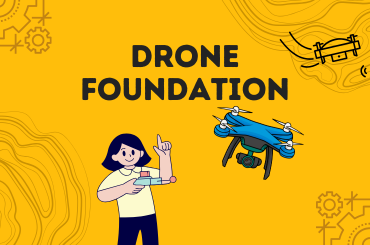1668A, 14th Main Rd, Sector 7, HSR Layout, Bengaluru, Karnataka 560102
+91 99459 30733 (9am - 6pm IST, Saturday - Sunday) (10am - 7pm IST, Tuesday - Friday)

Drone Foundation is a hands-on, two-month foundational course in aeronautics and drone technology designed specifically for curious minds aged 11+.
Through the interactive weekend sessions (2 hours each), students are introduced to the exciting world of aviation—from understanding the global and Indian civil aviation regulatory frameworks (ICAO, DGCA, MoCA, etc.) to grasping core aerodynamics, flight principles, and aircraft stability.
The curriculum takes learners through key scientific laws:
Newton's Law
Bernoulli's Law
Aerodynamic Forces
Wing
Propeller Designs
& crucial topics like aircraft Mass and Balance.
It also equips them with essential knowledge in Indian air regulations, human performance in aviation, and professional radio telephony procedures using ICAO-standard phraseology and Q-codes.
By integrating real-world aviation concepts with drone-specific terminology and practices, this course builds strong theoretical and practical competence. It serves as a foundational stepping stone for students aspiring to careers in drone piloting, aerospace engineering, or general aviation.
Key Learning Outcomes:
Strong Theoretical Foundation
Gain a comprehensive understanding of aviation science and drone-specific flight systems, including how core principles apply to both manned and unmanned aircraft.
Career Readiness in Drone & Aviation Fields
Acquire the essential knowledge and skills required to pursue professional roles in drone piloting, aerospace engineering, aviation mechanics, or flight operations.
Hands-On Understanding of Aircraft & Drone Systems
Learn the operational mechanics of various aircraft and drones, including how lift, thrust, control surfaces, and balance contribute to stable flight.
Mastery of Aviation Communication Protocols
Develop communication skills using industry-standard protocols such as Radio Telephony (RT), ICAO phraseology, and the phonetic alphabet, essential for safe and clear communication in aviation environments.
Airspace Navigation and Interpretation Skills
Learn to interpret aviation charts, NOTAMs (Notices to Airmen), and drone zone maps to safely and legally navigate controlled and uncontrolled airspace.
Confidence in Flight Safety and Decision-Making
Explore human factors in aviation—such as situational awareness, fatigue management, and responsible decision-making—to build safety-first mindsets for drone operators and future aviators.
This comprehensive course is designed to build a solid foundation in both civil aviation and unmanned aerial vehicle (UAV) systems. Students will gain essential theoretical knowledge and practical insights into drone operations, air regulations, aerodynamics, navigation, meteorology, and safety protocols. Ideal for aspiring drone pilots, aerospace students, and aviation enthusiasts.
Module 1: Introduction to Civil and Drone Aviation Governance
Understand the global structure of aviation through ICAO (International Civil Aviation Organization).
Learn about key aviation authorities in India: MoCA, DGCA, AAI, BCAS, AAIB.
Explore important aviation terminologies, definitions, and abbreviations.
Study standard measurement systems used in Indian aviation.
Module 2: Principles of Aerodynamics
Discover how the laws of physics govern flight and aircraft behavior.
Analyze the four primary forces: Lift, Drag, Thrust, and Weight.
Understand airfoil design, wing structures, and airflow dynamics.
Explore the three axes of motion and how they affect aircraft stability.
Module 3: Mass, Balance, and Propulsion
Understand the impact of weight distribution on aircraft performance.
Compare types of wings and their aerodynamic efficiency.
Learn the basics of propeller design and thrust generation in drones.
Module 4: Air Regulations, Human Factors, and Radio Telephony
Air Regulations:
Learn Indian Civil Aviation Requirements (CAR) and standard operational rules.
Distinguish between Visual Flight Rules (VFR) and Instrument Flight Rules (IFR).
Human Factors:
Explore the SHELL model and Aeronautical Decision Making (ADM).
Understand how fatigue, stress, and communication impact flight safety.
Learn Crew Resource Management (CRM) practices.
Radio Telephony:
Master aeronautical radio communication protocols.
Practice ICAO-standard phraseology and the phonetic alphabet.
Understand Indian-specific call signs, procedures, and emergency signals.
Module 5: Aviation Meteorology
Study atmospheric conditions that affect flight and UAV stability.
Identify cloud types, visibility levels, and weather patterns.
Learn how tropical systems and local climate influence flying conditions.
Interpret basic weather forecasts and their aviation implications.
Module 6: Fundamentals of Air Navigation
Understand core navigation principles and how aircraft are guided.
Learn to use aircraft instruments and radio navigation aids.
Study compass behavior, temperature variation, and flight pressure effects.
Get introduced to route planning and real-time flight monitoring.
Module 7: Introduction to Unmanned Aerial Vehicles (UAVs)
Classify different types of drones based on size, use-case, and capabilities.
Understand the internal systems and parts of drones.
Explore how drones differ from traditional manned aircraft in control and performance.
Module 8: Drone Operations, Regulations, and Best Practices
Learn the certification process for becoming a licensed UAV pilot in India.
Understand Indian airspace classification, drone zones, and safety protocols.
Get familiar with drone remote controllers, frequencies, and data links.
Follow essential pre-flight checklists and operational best practices for safe flying.